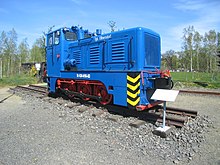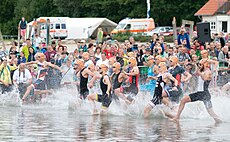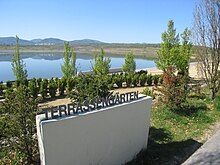Olbersdorfer See
| Olbersdorfer See | ||
|---|---|---|

|
||
| Geographical location | Olbersdorf municipality , Görlitz district , Saxony , Germany | |
| Tributaries | Grundbach | |
| Drain | Grundbach → Mandau | |
| Data | ||
| Coordinates | 50 ° 53 '24 " N , 14 ° 46' 49" E | |
|
|
||
| Altitude above sea level | 236.5 m | |
| surface | 60 ha | |
| Maximum depth | 40 m | |

|
||
| Water level meter at Olbersdorfer See 1998 | ||

The Olbersdorfer See is a residual open pit lake in the area of the municipality of Olbersdorf in the district of Görlitz in Germany. With 60 hectares, it is the largest body of water in the area around Zittau and serves as a recreational and recreational body of water .
Circular trails of 4.5 kilometers and 6 kilometers in length lead around the lake. The storage volume of the lake, which is up to 40 meters deep, is around 6 million cubic meters. Its water surface is at a height of 236.5 meters above sea level.
geography
The Olbersdorfer See fills the central mining area of the former Olbersdorf opencast mine . The Zittau lignite basin is about seven kilometers wide and sixteen kilometers long lignite area that extends in a northeast-southwest direction. It consists of two Flözkomplexen , wherein the Unterflöz a thickness of about 10 to 15 meters and the Oberflöz has a thickness of about 50 meters. The Olbersdorf opencast mine was located in the southwestern part of this deposit. The upper seam in Olbersdorfer Niederdorf extends almost to the surface of the ground, so that it used to be easy to extract lignite in pits and shafts.
As a scenic element, the lake in the foothills of the Zittau Mountains blends in with the Upper Lusatian hill country and the Neisse region and the Zittau basin . The lake is fed by the Grundbach . This flows into the Mandau , which in turn flows into the Lusatian Neisse .
history
Mining attempts and underground mining 1799–1913
In 1799, at the instigation of the then boss, drilling tests were carried out, with the help of which the presence of lignite was investigated. In 1800 a huge deposit of brown coal was found next to the Kretscham in Olbersdorf, where a shaft and a tunnel were driven in two places . This extracted coal was used in particular for heating ovens. Previously, the coal extracted was mainly used to fertilize the fields and less as fuel. The manure coals were threshed with flails .
In 1810 a company called the “Social Mineral Mining Association of Olbersdorf” came together, which founded the mine. This company bought the second mill property in Niederolbersdorf in 1812. In 1817 the art works for pumping up the underground water was built.
Several accidents occurred in 1817, 1853 and 1858. The miners' army of around 95 men received uniforms around 1850. A new outfit for 20 men, also black and red as before, happened in 1856.
In 1908 the Olbersdorfer lignite works were founded, which began to develop the mine field in August 1909. The coal was mined underground in piers until March 1911 . In 1913 a chain railway was put into operation, underground mining stopped and the shafts filled.
Open pit history 1910–1938
In the open pit only the surface seam was mined, from 1910 parallel to the underground mining. In 1917 a cable car was built to the power station in Olbersdorf.
Operation in the "Glückauf" mine was discontinued in 1938 after the first slide in the inner dump in 1933 and the competition with the Herkules mine in Türchau had become too great. The opencast mine was abandoned and the mine was left to run by itself. Then it filled with rising groundwater .
Opencast mining history 1947–1991
After the end of the Second World War, open-cast mining was resumed in 1947 in order to supply the industry in and around Zittau with raw lignite. In 1948, a 2.4-kilometer connecting line to the Olbersdorf-Oberdorf station was built on the Zittau-Oybin / Jonsdorf narrow-gauge railway , which went into operation in 1949. In the same year there was also a four-meter flood subsidence. From 1958, the lignite was no longer extracted manually, from then on grab excavators were used. A bucket wheel excavator was implemented in 1966. In 1975 the opencast mine was assigned to the "Hagenwerder lignite plant" and from 1985 onwards, two additional fields were systematically expanded. The expansion ensured the supply of coal for the Hagenwerder and Hirschfelde power plants. The Zittau coal was known for its excellent chargeability.
The open-cast mine left a 38 m deep remaining hole. Because of the planned expansion to the large open-cast mine Zittau-Süd, parts of the Olbersdorf Niederdorf were relocated to the new construction area in the Oberdorf. The so-called Kirchberg view provides an excellent view of the open-cast mine area. This is where the Protestant church in Olbersdorf, built in 1883, had to give way to the planned expansion of the opencast mine in 1986 by blasting it. Today a plaque and the iron cross on the spire reminds of this fact. In 1988 the heating plant in Olbersdorf was put into operation.

The Council of Ministers of the GDR decided on March 1, 1990 to stop coal production in Olbersdorf. The actual cessation took place on September 30, 1991. In the entire open-cast mine from 1908 to 1991 a total of 21.5 million tons of coal were mined.
On June 3, 1991, the renovation work began as part of job creation measures . Several contaminated sites were rehabilitated, opencast mining buildings and technology were dismantled and dismantled. Bank zones were created, support fillings were made, embankments were flattened and an extensive network of paths was created.
The groundwater began to rise in August 1996 when the pumps were taken out of service. The open pit was flooded between September 15, 1996 and March 2, 1999 by introducing the Grundbach and Goldbach .
Mining renovation and state horticultural show
The 2nd Saxon State Garden Show took place from May 7th to October 17th, 1999 in Olbersdorf and Zittau and had the motto "Landscape after mining". A total of DM 20 million was invested in the execution of the project , of which DM 17.5 million was funded. The city of Zittau had already applied to host this garden show in 1992. On February 27, 1994 it was awarded the contract and the first planning work for the design of the post-mining landscape began. The remaining open-cast mine was flooded by 1999 and all renovation work was completed. The "Zittau onion" served as the mascot of the 2nd Saxon State Garden Show.
With the advanced renovation of the opencast mining area, landscape elements were created for the state horticultural show. Various themed gardens , an avenue of lime trees were laid out and a lawn ground floor was completely redesigned. The other part of the show was in the Zittau West Park, which has valuable old trees. The former outdoor pool has been redesigned into a water lily pool with a large park lawn. Two bridges were built to cross the Mandau. The park bridge was inaugurated in 1998. Various indoor shows took place in the new greenhouse of the city nursery. The earth pyramids, the silhouette of the Zittau Mountains on a vantage point, the wide flight of stairs to the beach, the water playground, the beach hill with the snail hiding spots and various old open-cast mining equipment, including the six-meter-high paddle wheel, are "permanent" features that still exist today , to call.
use
Today the lake is used for recreation. Extensive recreational sports options, e.g. B. for swimming , beach volleyball , surfing are available. There is also a fish restaurant, hotels, a campsite, etc. Fishing is also possible.
The lake is not used for water supply or flood protection. He has an island to which birds can retreat.
Every year in August, the cross- striathlon O-See Challenge takes place, which is classified as a ranking run of XTERRA Germany and in which German champions were crowned for the first time in 2007. For the young athletes as well as children and young people there is the O-See X'KIDS Challenge at the same time . In 2014, the ITU Cross Triathlon World Championship was held at Lake Olbersdorf as part of the O-See Challenge . In 2011 and 2016, the XTERRA European Championship also took place as part of the sporting event, which will be held on site for the third time in 2018.
In addition, beach volleyball championships are held regularly at Lake Olbersdorf.
The north beach has very good bathing conditions and accessibility. There is another bathing option on the south beach, but it can only be reached via the path system.
See also
Individual evidence
- ↑ Olbersdorf opencast mine (1910–1991). (Pdf, 1.6MB) LMBV , accessed on January 29, 2014 .
- ↑ a b c d e f g Freizeit-Oase Olbersdorfer See e. V. - History of the open pit
- ↑ Competition overview O-See-Challenge. Retrieved January 29, 2014 .
- ↑ 2014 Zittau ITU Cross Triathlon World Championships. Water and surfing club Zittau e. V., accessed on January 29, 2014 .
- ↑ XTERRA Germany 2018 = XTERRA European Championship 2018 . In: O-SEE Challenge . ( o-see-challenge.de [accessed on November 29, 2017]). XTERRA Germany 2018 = XTERRA European Championship 2018 ( Memento of the original from December 1, 2017 in the Internet Archive ) Info: The archive link has been inserted automatically and has not yet been checked. Please check the original and archive link according to the instructions and then remove this notice.
literature
- Tatjana Fjodorowa, Daniela Niedel, Gerd Peschke: The Olbersdorfer See and its water balance. in: Sächsische Heimatblätter 47 (2001) 4-5, pp. 242-250
- Hermann Preßler: Contributions to the knowledge of the Zittau brown coal . Zittau 1843 ( digitized [accessed on January 29, 2014]).






